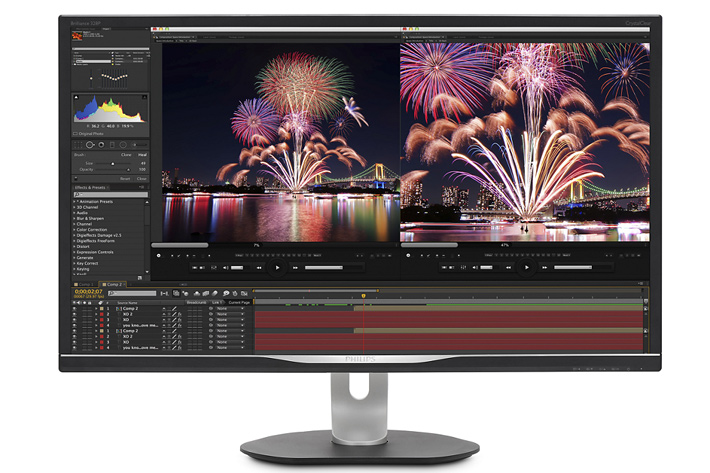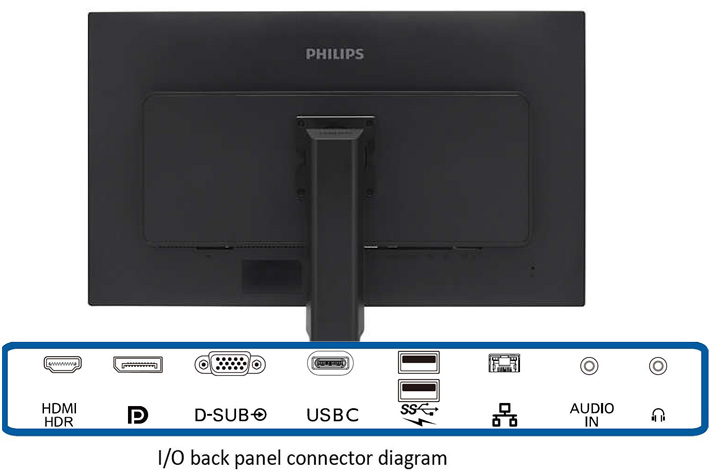
Presented as perfect for graphic designers, CAD engineers, photographers, video editors and other professionals, the new monitor from Philips has an attractive price: $499. Can the Philips 32-inch 328P6AUBREB deliver?
At the moment I do not have an answer for you, but I may well have one soon, this soon being early next year, when the new monitor, just announced, will be available. The new monitor, added to Philips P-line of monitors, follows the logic of that line: monitors designed to deliver precise, accurate and colour-critical colour performance. Demonstrated earlier this year, the – effectively – 31.5” QHD display supports the AdobeRGB color gamut and represents, for me, a step into the future, has it offers a built-in USB-C dock that features USB ports, a gigabit Ethernet port, and conforms to USB Power Delivery specifications to support power to laptops.
Before I continue, let me say that my sudden interest on a new monitor reflects the imminent demise of my main monitor, a Dell U3011 bought in 2012, to replace another 30-inch monitor, the HP LP3065. The Dell has served me well, but a few days ago its screen started to go black and I’ve to disconnect it from the mains, wait a few seconds and reconnect it again to get it working. After checking cables, changing ports and confirming that connections are OK, there is no doubt there is a problem with the monitor. The issue is largely commented online, and apparently there are not many solutions for it, not even from Dell. I tried to get support from Dell, but getting support from the company where I am based is like a nightmare. So, instead of keep trying, I decided to look for a new monitor.

My previous experience with the HP monitor, which I sent to be repaired, only to have the technicians frying it – and I am still waiting, since 2012, for the insurance company Allianz to get back to me with an answer to that situation – makes me believe it is better to buy a new monitor than to try to get an old monitor repaired. Repairing an old monitor is a bit like trying to repair those old CRT monitors or TVs from the past: you would fix a component only for another one to break the following week. So, when looking at the price Philips asks for this new monitor, it makes more sense to buy a new one than to have the Dell repaired. $499 for a new 32 inch monitor is an interesting price, and it shows that prices keep going lower. It’s a trend I’ve written about in previous guides, so it is good to confirm it is still working.
I looked around for monitors, and there are some interesting solutions available or about to reach the market, and I will soon, before Christmas, write a guide about monitors to buy in 2018, but for now I want to look at the Philips, because it seems to fit my needs, and give me access to recent technology. According to the information provided by Philips, the 328P6AUBREB is equipped with the extremely versatile connectivity of the latest-generation USB 3.1 Type C technology. Featuring a slim, reversible connector, USB-C enables users to charge, transfer audio and video signal, and connect to the Internet – all with one single cable. Hence, the monitor instantly becomes a hub and serves as a docking station, just without using that extra space on the desk.
Consequently, USB-C extends the limited connectivity of notebooks and allows users to transfer data securely at ultra-fast speeds. USB 3.1 is 20 times faster than USB 2.0, making data transfer a breeze. And, for those whose devices seem to always be running low on battery, USB-C with power delivery can even charge notebooks. The monitor also makes it easy to link multiple monitors, which suits me as sometimes I need to have an extra monitor connected.
Why not buy a 4K UHD monitor, you’ve probably asked by now? Well, I rather have a QHD, which is suitable for my needs at the moment, and does not make me rush my building of a new computer. In fact, the problem when you go to higher resolutions is to have a computer/graphics card able to manage the extra pixels. The 2560×1440 from the Philips 328P6AUBREB gives me an excellent working space, and I will gladly trade a few pixels in resolution – remember that now I’ve 2560×1600 – for the gain in size, as this is a 32-inch against my 30-inch.
This monitor is a 16:9, against my Dell, which is a 16:10. It looks as if the 16:10 2560×1600 type monitors that some 10 years ago seemed to be on the verge of becoming common have vanished, and it is mostly 16:9 monitors you’ll find, if you’re not looking after one of those odd panoramic models. This Quad HD will offer me, according to Philips, “an excellent viewing experience with high-resolution visuals”. I’ve contacted Philips today, and now I just have to wait until the monitor is available.
The monitor also offers HDR technology, ensuring exceptional brightness and contrast, as well as a rich palette of captivating new colours never before seen on a display. Philips adds that “the 10-bit display offers 1.074 billion of them, supported by 12-bit internal processing for natural colours and smooth gradients. With 99% Adobe RGB and 100% sRGB (CIE 1973), the 328P6AUBREB offers professional colour standards and 2560 x 1440 pixels deliver crystal-clear images and make graphics come alive. Thanks to IPS technology, the monitor can be viewed from an angle of 178° without losing any of the colour accuracy or consistent brightness that professional applications demand.”
Explaining the display’s positioning, Artem Khomenko, Product Manager Philips Monitors Europe at MMD, says: “The P-line monitors are designed to deliver precise, accurate and colour-critical colour performance. We are proud to bring this new model to the market, and to meet the high standards of professionals. This model is the perfect fit for graphic designers, CAD engineers, photographers, video editors and other professionals who rely on an outstanding on-screen reproduction of fine details.”
The new 32-inch QHD display also offers features that are common on Philips monitors: the SmartErgoBase ergonomic adjustable stand enables users to tilt, swivel and raise the display for maximum viewing comfort, or the Philips LowBlue Mode which reduces potentially harmful shortwave blue light. Flicker-free technology regulates brightness and reduces flicker for even more comfortable viewing.
Although I would do without, the monitor also comes with built-in stereo speakers which, says the company, provide excellent audio reproduction while eliminating the need for peripheral speakers… I may get used to that, now I think about it! One more thing about the new monitor: Philips says it is made of 65% post-consumer recycled plastics, meaning it is a good choice for eco-friendly users. I am in… now I just need to get my hands on the monitor and see if it really lives to the promises made. Somehow, it is a return to Philips, as I’ve used their CRT monitors many years ago and remember how well they performed.
The Philips 32-inch 328P6AUBREB will be available in Europe January 2018 and there is no information, yet, when it will be available in the United States. The price, though, will be around the $499 mentioned, using the European price as reference.

